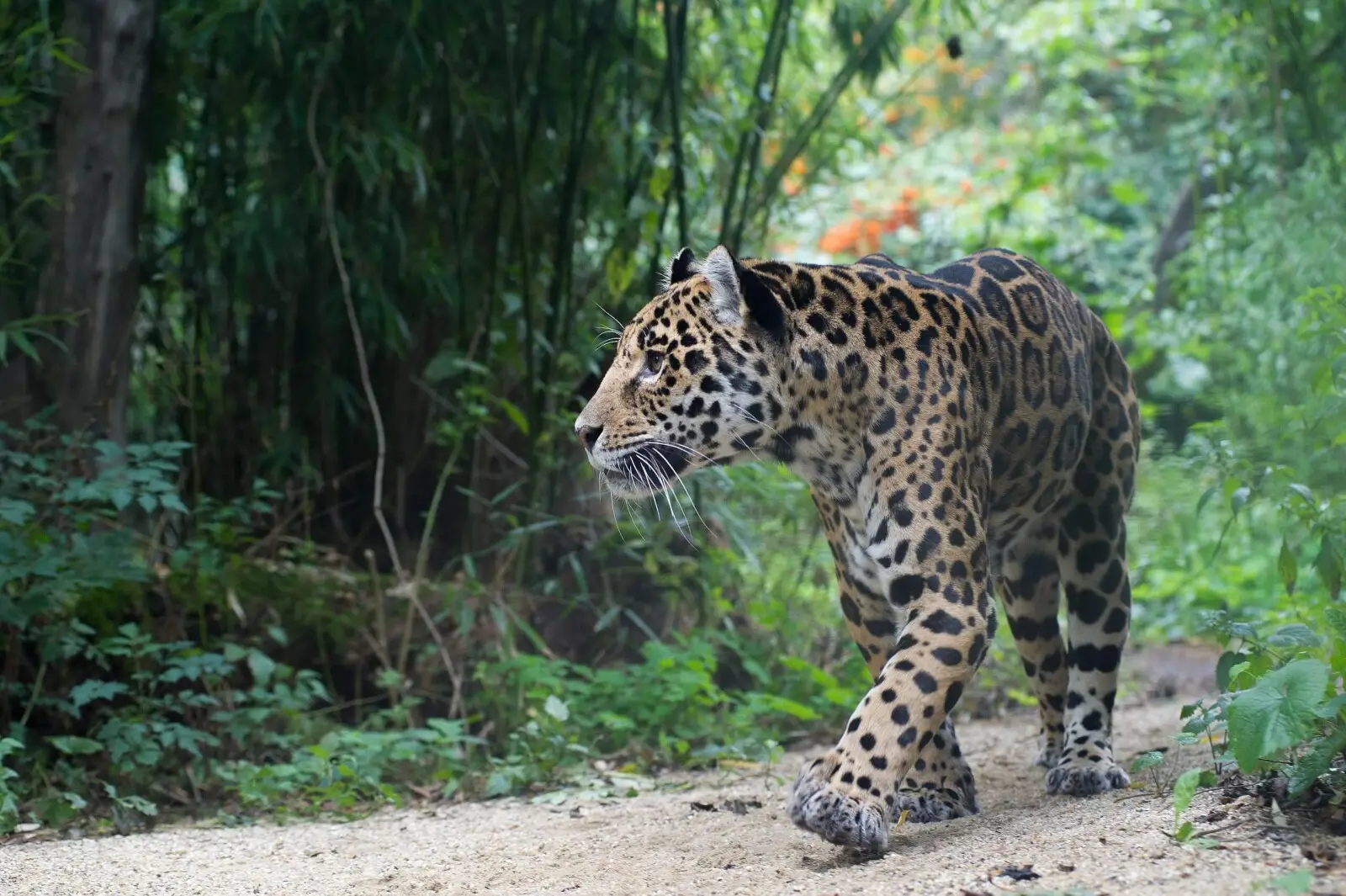The Amur leopard (Panthera pardus orientalis) is a subspecies of leopard found in the temperate forests of the Russian Far East and northeastern China. Known for its stunning golden fur adorned with dark rosettes and a coat that adapts to the changing seasons, this elusive predator is one of the rarest and most endangered big cats in the world. With fewer than 100 individuals remaining in the wild, the Amur leopard’s population is teetering on the edge of extinction.

In this article, we will explore the natural history, behavior, adaptations, and the urgent conservation efforts required to prevent the extinction of the Amur leopard, along with the main threats it faces in its rapidly declining habitat.
Physical Characteristics of the Amur Leopard
The Amur leopard shares many physical characteristics with other leopard subspecies, but it has evolved some distinctive traits to help it survive in the harsh, cold environment of the Russian Far East. On average, an adult Amur leopard weighs between 32 and 48 kilograms (70 to 106 pounds), with males being larger than females. They have a sleek, muscular body built for both stealth and agility.
The Amur leopard’s most defining feature is its beautifully spotted coat. The fur is dense and pale yellow in color, dotted with dark rosettes. Unlike many other leopard subspecies, the Amur leopard’s coat becomes even thicker and more luxurious in the winter, with a lighter coloration that allows it to blend into the snowy, forested landscapes. This seasonal change in the coat’s texture and color provides the Amur leopard with the ability to camouflage itself against both the forest’s trees and the snowy ground, making it an even more elusive predator.
The Amur leopard’s eyes are a striking amber hue, giving it a piercing gaze that is perfectly suited for nighttime hunting. Its long tail, measuring up to 80 cm (31 inches) in length, is an essential tool for maintaining balance and maneuvering in the dense undergrowth of its forested habitat.
Habitat and Distribution
Historically, the Amur leopard’s range stretched across much of the Russian Far East, northeastern China, and parts of the Korean Peninsula. However, due to habitat loss, hunting, and human encroachment, their population has been severely restricted. Today, the Amur leopard’s range is primarily confined to a small area in the far southeastern corner of Russia and parts of northeastern China, mainly in the Russian Primorye region and the adjacent areas of northeastern China.
The habitat of the Amur leopard is characterized by temperate forests, with a mix of deciduous and coniferous trees. This ecosystem provides the leopard with ample cover for stalking its prey and serves as a prime environment for the species to thrive. The region experiences harsh winters, with heavy snowfall and low temperatures, making it a challenging environment for both predators and prey. However, the Amur leopard has evolved perfectly to survive in this extreme landscape.
Behavior and Hunting
The Amur leopard is a solitary and nocturnal animal. Unlike lions, which live in social groups, the Amur leopard prefers to live alone and only comes into contact with others during mating season or when a female is caring for her young. This solitary behavior is a key survival trait in the dense forests where the leopard resides, as it avoids competition for resources and uses stealth to catch its prey.
As an opportunistic carnivore, the Amur leopard has a varied diet. Its prey consists of medium-sized mammals, such as roe deer, sika deer, hares, and wild boar, which are abundant in its forested habitat. Occasionally, it will target smaller animals like rabbits, and in rare cases, it may take down larger prey like the Manchurian wapiti (a type of elk). The Amur leopard is an ambush predator, stalking its prey quietly before pouncing with great speed and precision. Once it has captured its prey, the leopard will drag it into the trees or dense underbrush to avoid scavengers like wolves and bears.
The Amur leopard’s diet can vary depending on the season and the availability of prey. During winter, when food can be scarce, the leopard’s adaptability allows it to endure longer periods without a meal. It is known to travel great distances in search of food, sometimes covering up to 20 kilometers (12 miles) a night.
Reproduction and Life Cycle
The Amur leopard has a slow reproductive rate, which is one of the factors contributing to its vulnerability to extinction. Females typically give birth to one to three cubs, although litters of up to four cubs have been recorded. The gestation period for the Amur leopard lasts about 90 to 105 days, after which the female gives birth in a secluded den, often located in caves or hollow trees. Cubs are born blind and helpless, relying on their mother for warmth and nourishment. They begin to open their eyes around 10 days of age and are fully weaned by about 2 to 3 months old.
As cubs grow, they become more independent and start accompanying their mother on hunts, learning vital survival skills. By the time they are 12 months old, they are capable of hunting for themselves. However, cubs usually remain with their mother for up to 2 years before dispersing to establish their own territories.
Mating typically occurs in the winter months, with males and females coming together only for reproduction. After mating, the female raises her cubs alone, as males play no role in parental care.
Threats to the Amur Leopard
The Amur leopard’s population has drastically declined due to a combination of natural and human-driven factors. The following are the main threats that continue to endanger the species:
- Habitat Loss and Fragmentation: One of the most significant threats to the Amur leopard is habitat loss. Logging, road construction, and agricultural expansion have reduced the size and quality of the leopard’s natural habitat. Deforestation, combined with the fragmentation of the landscape, has isolated populations and made it harder for the leopards to find sufficient food and suitable mates.
- Poaching: Poaching is another major threat to the Amur leopard. Although the species is protected by law in both Russia and China, illegal hunting continues to pose a significant risk. Amur leopards are targeted for their beautiful pelts, which are highly prized on the black market, and for their bones, which are sometimes used in traditional medicine.
- Human-Wildlife Conflict: As human populations grow in the regions surrounding the Amur leopard’s habitat, the likelihood of conflict increases. In some areas, leopards are hunted by local communities in retaliation for livestock predation or as a result of habitat encroachment. Such conflicts further reduce the population of the Amur leopard.
- Prey Depletion: The depletion of prey species, caused by poaching and habitat loss, also negatively impacts the Amur leopard. Without a steady supply of prey, the survival of the leopard population is jeopardized, as they may struggle to find enough food to survive and reproduce.
- Climate Change: The effects of climate change on the Amur leopard’s habitat are not fully understood, but changes in temperature, precipitation, and vegetation could further threaten the species. Climate change may alter the availability of prey, increase the frequency of extreme weather events, and exacerbate habitat loss.
Conservation Efforts
In response to the dire situation facing the Amur leopard, several international organizations and governments have taken action to protect the species. These efforts include:
- Protected Areas and Wildlife Reserves: In Russia, the Amur leopard is now found in the Land of the Leopard National Park, a dedicated conservation area in the Russian Far East. This park provides the leopards with a safe environment free from the pressures of habitat loss and poaching. Efforts to expand protected areas in China and Russia are ongoing, with the aim of ensuring that the Amur leopard’s range remains intact.
- Anti-Poaching Measures: Law enforcement agencies in both Russia and China are working to combat illegal poaching. This includes surveillance, poacher patrols, and stricter penalties for those caught hunting or trafficking in Amur leopards.
- Research and Monitoring: Conservationists are closely monitoring the Amur leopard population through camera traps, GPS tracking, and other research tools. These efforts help to track the leopards’ movements, monitor their health, and assess the success of conservation strategies.
- Community Involvement: Involving local communities in conservation efforts is crucial to the survival of the Amur leopard. Programs aimed at educating local populations about the importance of protecting the species and mitigating human-leopard conflict are essential in ensuring the species’ long-term survival.
Conclusion
The Amur leopard is an incredibly rare and majestic animal, but its population is hanging by a thread. With fewer than 100 individuals remaining in the wild, it faces numerous challenges, including habitat loss, poaching, and prey depletion. However, ongoing conservation efforts are providing hope for the future of this critically endangered species.
With continued protection of its habitat, increased anti-poaching efforts, and the involvement of local communities, the Amur leopard may have a chance to recover. It is crucial that the global community continues to rally behind the Amur leopard’s survival, ensuring that future generations can witness the beauty and majesty of this remarkable feline in the wild.





























